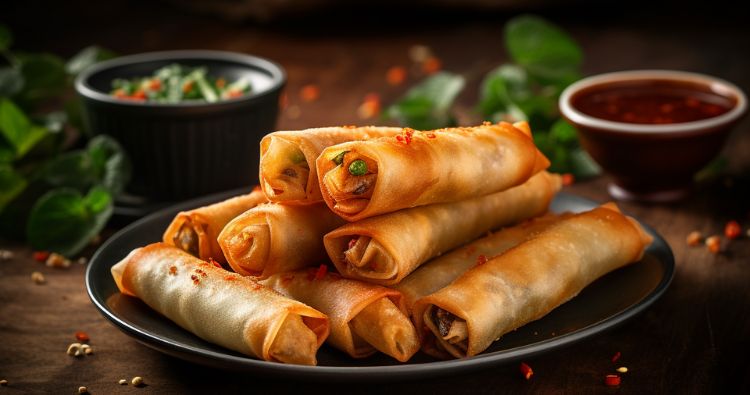They are known for their crispy exterior and flavorful fillings, making them a favorite in many households and restaurants.
Chapter 1: The Origins of Spring Rolls
Spring rolls have a rich history that dates back to ancient China. Traditionally, they were made to celebrate the arrival of spring, symbolizing renewal and prosperity. The rolls were filled with fresh vegetables, representing the new growth of the season. Over time, spring rolls have evolved and spread across Asia and the world, with each region adding its unique twist to the recipe.
Chinese Spring Rolls
In China, spring rolls are known as "chun juan" and they are typically served during the Lunar New Year. Chinese spring rolls can be filled with a variety of ingredients, including vegetables, meat, and seafood. They are usually deep-fried to achieve a crispy texture.
Vietnamese Spring Rolls
Vietnamese spring rolls, are often served fresh (not fried) and are made with rice paper wrappers. These rolls are filled with fresh herbs, vermicelli noodles, shrimp, or pork, and are commonly served with a peanut or hoisin dipping sauce.
Thai Spring Rolls
In Thailand, spring rolls, known as can be either fresh or fried. Thai spring rolls often include ingredients like glass noodles, bean sprouts, and minced pork, and are served with a sweet and sour dipping sauce.
Chapter 2: Variations of Spring Rolls
Spring rolls come in many shapes and sizes, with fillings and wrappers varying based on regional preferences and dietary needs. Here are some popular variations:
Vegetarian Spring Rolls
Vegetarian spring rolls are filled with a medley of fresh vegetables such as cabbage, carrots, bell peppers, and mushrooms. Tofu can also be added for extra protein. These rolls are perfect for those following a plant-based diet.
Seafood Spring Rolls
Seafood spring rolls often feature ingredients like shrimp, crab, or fish. These rolls are particularly popular in coastal regions and offer a fresh and flavorful alternative to traditional meat-filled rolls.
Dessert Spring Rolls
Dessert spring rolls are a sweet twist on the classic savory dish. They can be filled with fruits like bananas, apples, or mangoes, and are often drizzled with chocolate or caramel sauce. These rolls can be fried or served fresh.
Chapter 3: Making Spring Rolls at Home
Creating spring rolls at home is a fun and rewarding experience. Here are some essential tips and a basic recipe to get you started:
Tips for Perfect Spring Rolls
Wrappers: Choose the right type of wrapper for your recipe. Rice paper wrappers are ideal for fresh rolls, while wheat-based wrappers are better for frying.
Preparation: Prepare all your ingredients before you start assembling the rolls. This includes chopping vegetables, cooking proteins, and preparing dipping sauces.
Rolling Technique: Place the filling on the lower third of the wrapper, fold the sides over the filling, and then roll tightly to enclose the filling completely.
Frying: If frying, ensure the oil is hot enough (around 350°F or 175°C) to achieve a crispy exterior without making the rolls too greasy.
Basic Spring Roll Recipe
Ingredients:
Spring roll wrappers (rice paper or wheat-based)
1 cup shredded cabbage
1 cup grated carrots
1 cup bean sprouts
1/2 cup sliced bell peppers
1/2 cup cooked shrimp or chicken (optional)
Fresh herbs (mint, cilantro, or basil)
Dipping sauce (soy sauce, peanut sauce, or sweet chili sauce)
Oil for frying (if making fried spring rolls)
Instructions:
Prepare the Ingredients: Wash and slice all vegetables. Cook and shred the protein if using.
Assemble the Rolls: Soak the rice paper wrappers in warm water for a few seconds until pliable. If using wheat-based wrappers, follow package instructions. Place a small amount of each filling ingredient on the wrapper, fold the sides, and roll tightly.
Fry the Rolls (if desired): Heat oil in a deep pan. Carefully place the spring rolls in the hot oil and fry until golden brown and crispy. Remove and drain on paper towels.
Serve: Arrange the spring rolls on a platter and serve with your choice of dipping sauce.
Chapter 4: Serving and Enjoying Spring Rolls
Spring rolls are best enjoyed fresh, straight from the kitchen. They can be served as an appetizer, a snack, or as part of a larger meal. Pair them with a variety of dipping sauces to enhance their flavor. Popular options include soy sauce, hoisin sauce, peanut sauce, and sweet chili sauce.
Hosting a Spring Roll Party
A spring roll party is a fun and interactive way to enjoy this delicious dish with friends and family. Set up a spring roll station with different fillings, wrappers, and dipping sauces. Encourage guests to create their own rolls, experimenting with various combinations of ingredients.




Comments (0)